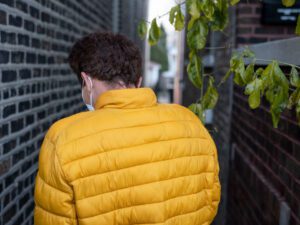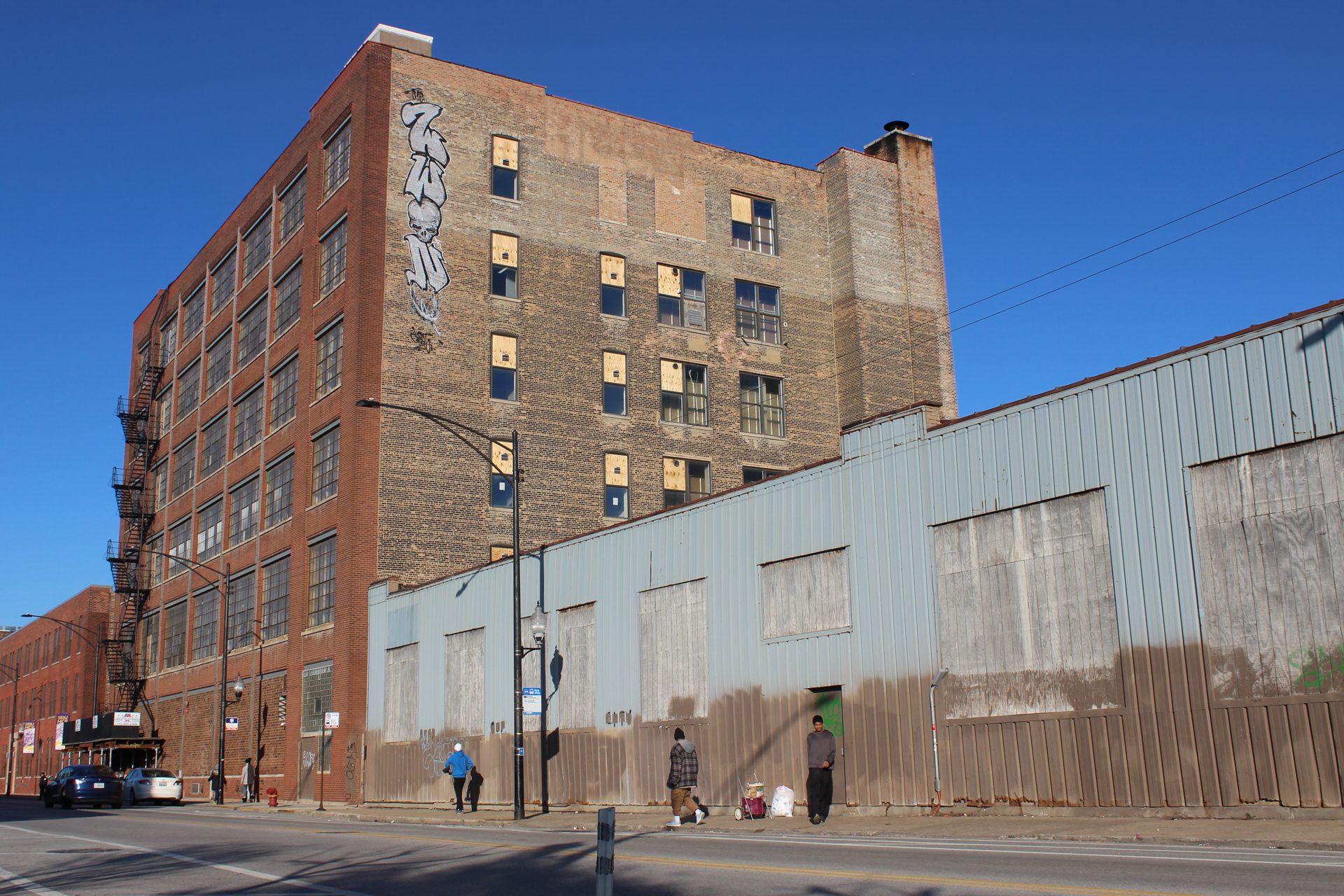 Mauricio Peña/Borderless Magazine
Mauricio Peña/Borderless MagazinePocos días después de que el gobernador de Illinois, Pritzker, cerrara un albergue propuesto por motivos sanitarios, los inmigrantes venezolanos que viven en el albergue de Pilsen afirman que se les trata "como a perros".
María* siente el polvo y las partículas parecidas a fibras que caen del techo y de la manta sobre su familia cada vez que intenta dormir en su catre de emergencia enclavado entre otros cientos de migrantes venezolanos.
Casi todas las noches hace frío. Si hay calefacción en el edificio, ella no la siente.
¿Quieres recibir historias como esta en tu correo cada semana?
Suscríbase a nuestro boletín gratuito.

María llegó al antiguo almacén convertido en refugio para inmigrantes del barrio de Pilsen de Chicago hace unos dos meses. En conjunto, ha sido una experiencia deshumanizadora. Desde temperaturas gélidas hasta baños sucios y comida a veces en mal estado, las condiciones de vida han sido horribles, dijo.
"No puedes tener nada aquí", dijo María. "Nada. Nada de intimidad".
Desde fuera, el edificio de ladrillo de seis plantas y el contiguo de una planta con paneles de madera se parecen a muchos otros inmuebles del corredor industrial de Pilsen: destartalados, con algunas ventanas tapiadas y la fachada pintada al azar para tapar grafitis. Pocos de los que salen de la cercana I-90 para ir de compras a Chinatown o a comer a Pilsen adivinarían que el antiguo edificio industrial alberga ahora el mayor centro de acogida de inmigrantes de la ciudad. Más de 2.300 inmigrantes recién llegados -todos ellos familias, algunas con bebés y niños pequeños- llaman ahora al antiguos edificios de fabricación, según una nota interna de la ciudad obtenida por Borderless.
El centro de Pilsen, que se extiende a lo largo de media manzana entre Cermak Road y el brazo sur del río Chicago, se inauguró este otoño durante la lucha de la ciudad por sacar a los inmigrantes de las comisarías en medio del descenso de las temperaturas. Sin embargo, las entrevistas con las personas que viven en el refugio y los vídeos que Borderless revisó de las condiciones en el interior del edificio muestran que el resultado de esa lucha es un edificio que no cumple las normas básicas de alojamiento de emergencia establecidas por la Agencia de la ONU para los Refugiados.
Más de una docena de migrantes compartieron su experiencia con Borderless bajo la condición de permanecer en el anonimato por temor a ser reprendidos y expulsados del refugio de Pilsen. Se lamentaron de las duras condiciones del albergue, como el hacinamiento, los malos tratos de los trabajadores, las bajas temperaturas y los baños insalubres. La administración del alcalde Brandon Johnson no respondió a las preguntas de Borderless Magazine.
En las últimas semanas, los migrantes han descrito brotes de diversas enfermedades, como varicela, gripe e infecciones de las vías respiratorias superiores, que se propagan sin atención médica suficiente. Las experiencias de los migrantes en el refugio de Pilsen ofrecen una visión de la red de refugios de emergencia de la ciudad, abiertos apresuradamente para albergar a los migrantes que se envían constantemente a Chicago desde la frontera desde agosto de 2022.
Para los inmigrantes en el albergue como María, hay algunas opciones.
"Estamos agradecidos por tener un techo porque acabamos de llegar, pero me gustaría que mejoraran cosas como la comida", dice María.
Las autoridades de Chicago se apresuran a alojar a los inmigrantes
Las autoridades municipales se han esforzado por alojar a miles de inmigrantes transportados en autobús desde Texas y otros estados fronterizos en los últimos 15 meses. Algunos 29.900 inmigrantes han llegado en autobús o avión desde agosto de 2022, según el cuadro de mandos público de la ciudad.
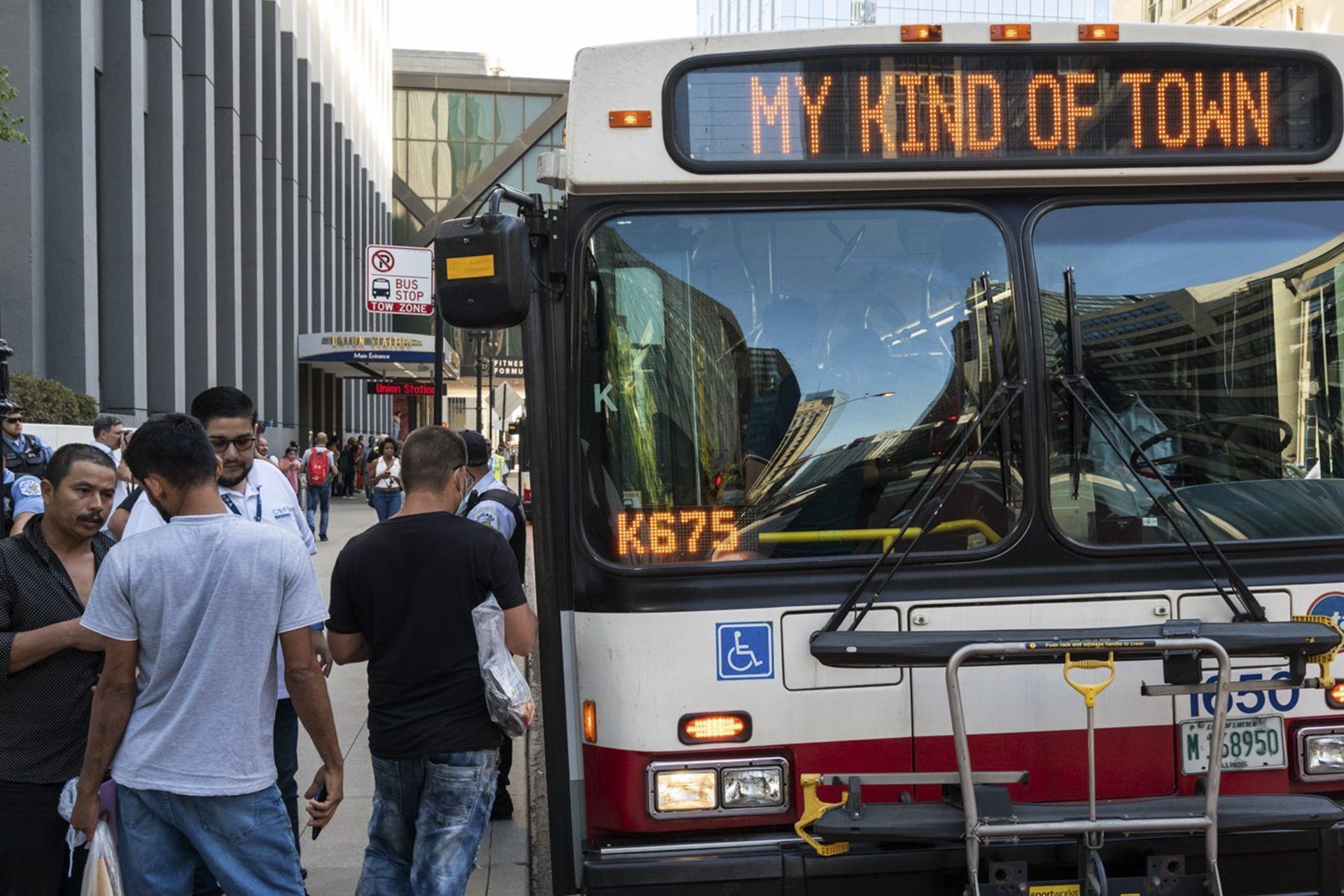
Acerca de 13.777 emigrantes viven en la red de albergues de la ciudad, mientras que otros 575 se encuentran fuera de las comisarías o en el aeropuerto internacional O'Hare a fecha de 13 de diciembre, según datos municipales.
El alcalde Johnson ha reafirmado el compromiso de la ciudad con los esfuerzos de reasentamiento de inmigrantes, afirmando en un comunicado de prensa que la ciudad estaba tratando "nuevos vecinos con compasión porque era lo humanitario y porque, con apoyo, pueden convertirse en miembros productivos de nuestras comunidades, contribuyendo a nuestra economía, nuestra cultura y nuestra sociedad.."
Pero la decisión de Johnson a finales de noviembre de acortar la estancia en los albergues al 60 días ha sido muy criticada por los defensores de los inmigrantes, que calificaron el cambio de "irrazonable" y denunciaron que la norma crearía inestabilidad para los inmigrantes. La mayoría de los inmigrantes recién llegados no pueden trabajar legalmente y, por tanto, no pueden alquilar un apartamento, una realidad que, según los defensores, llevará a los inmigrantes a quedarse sin hogar durante los meses más fríos, cuando se vean obligados a abandonar los refugios de la ciudad.
Johnson se ha enfrentado a un nuevo escrutinio por una polémica ciudad de tiendas de campaña en el barrio de Brighton Park, en Chicago, que iba a ser gestionada por GardaWorld. Los proyectos anteriores de la empresa de seguridad incluyen un centro de detención en El Paso para niños migrantes no acompañados. en el que se constató una "grave mala gestión", con denuncias de condiciones inseguras e insalubres y abusos sexuales contra los niños allí alojados.
La ciudad se vio obligada a desechar el campamento de tiendas de campaña parcialmente construido para el invierno en Brighton Park por motivos medioambientales y sanitarios el 5 de diciembre. El gobernador de Illinois, JB Pritzker, retiró la financiación del proyecto después de que la Agencia de Protección del Medio Ambiente de Illinois citara la preocupación de "Muestreo y remediación del suelo insuficientes". Registros municipales obtenidos por ABC7 muestran que la ciudad ya había gastado cerca de $1 millones en preparar el campamento antes de que se cerrara el proyecto. El miércoles, Pritzker dijo que GardaWorld cubriría estos costes y que GardaWorld ayudaría al Estado a crear más albergues para inmigrantes, incluidos albergues de ladrillo y mortero como el de Pilsen.
"Mi administración se compromete a mantener a salvo a los solicitantes de asilo mientras trabajamos para ayudarles a lograr la independencia", dijo Pritzker en un comunicado de prensa. "No procederemos a alojar a familias en un lugar en el que siguen existiendo graves problemas medioambientales".
A pesar de las consecuencias y el escrutinio del centro de Brighton Park, no está claro qué tipo de supervisión e inspecciones se llevan a cabo en los más de 20 refugios temporales de Chicago. Los migrantes dijeron a Borderless que no habían visto ninguna inspección regular del refugio, aparte de dos visitas separadas del departamento de bomberos para inspeccionar el techo del almacén de una sola planta.
En 2021, los registros de la ciudad muestran 2241 S. Halsted St. falló una inspección anual por el Departamento de Edificios. Los propietarios no mantenían el equipo del ascensor en condiciones de funcionamiento seguras. No está claro cuándo hizo correcciones el propietario del edificio ni cuándo se llevó a cabo una nueva inspección municipal en el lugar. La inspección de 2021 es la última de la que se tiene constancia.
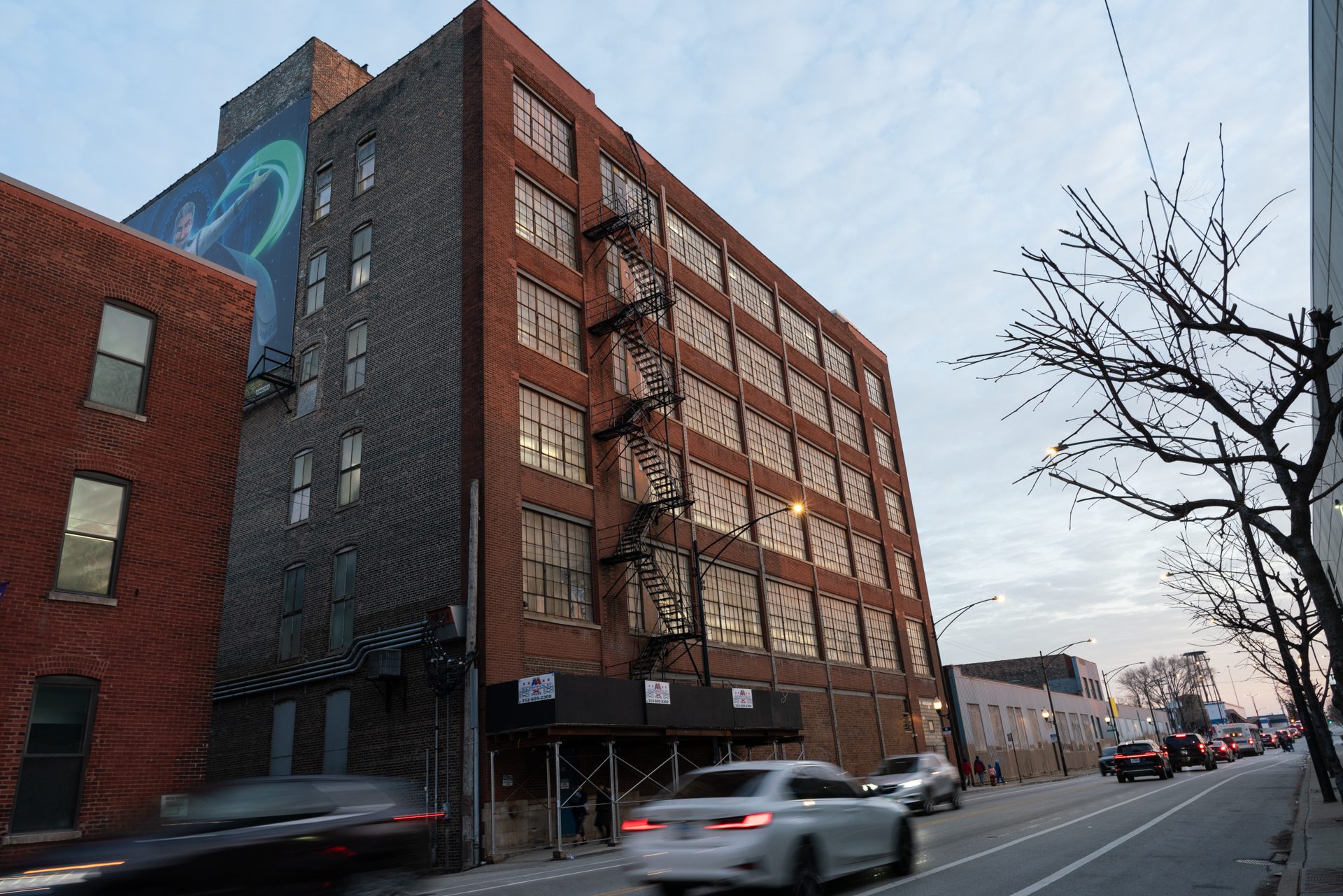
La última inspección del Departamento de Edificios registrada para el edificio contiguo de una planta en el 2301 S. Halsted Street se produjo en 2016.
Las autoridades municipales organizaron una reunión de última hora en octubre para anunciar los planes para el refugio temporal de Pilsen. En un comunicado, el concejal de Pilsen Byron Sigcho-López escribió que, como presidente de la Comisión de Vivienda y Bienes Inmuebles, "era mi deber abordar la crisis de la vivienda con soluciones prácticas y en colaboración con los departamentos municipales, las partes interesadas de la comunidad y las agencias hermanas".
En 2023, la ciudad gastó decenas de millones de dólares en refugios para inmigrantes. Entre los artículos, la ciudad dice que proporciona a los residentes del refugio un catre, una manta, una almohada, tres comidas al día, acceso a duchas, artículos de higiene y acceso a servicios de lavandería.
Durante la reunión, Sigcho-López y los funcionarios del Departamento de Servicios de Apoyo a la Familia, la Oficina de Gestión de Emergencias y Comunicaciones y la Policía de Chicago dijeron a los vecinos que el antiguo almacén sería con capacidad para 1.000 inmigrantes. Pero sólo dos meses después, esa cifra se ha más que duplicado, según los registros internos de la ciudad.
La vida dentro de un refugio
En el interior del refugio de Pilsen, decenas de catres, separados por centímetros, están agrupados por zonas en diversas áreas del edificio de una sola planta, según los vídeos mostrados a Borderless. El personal ha prohibido a los migrantes grabar o hacer fotos en el interior del refugio y los ha "amenazado" con echarlos si hablan con miembros de los medios de comunicación.
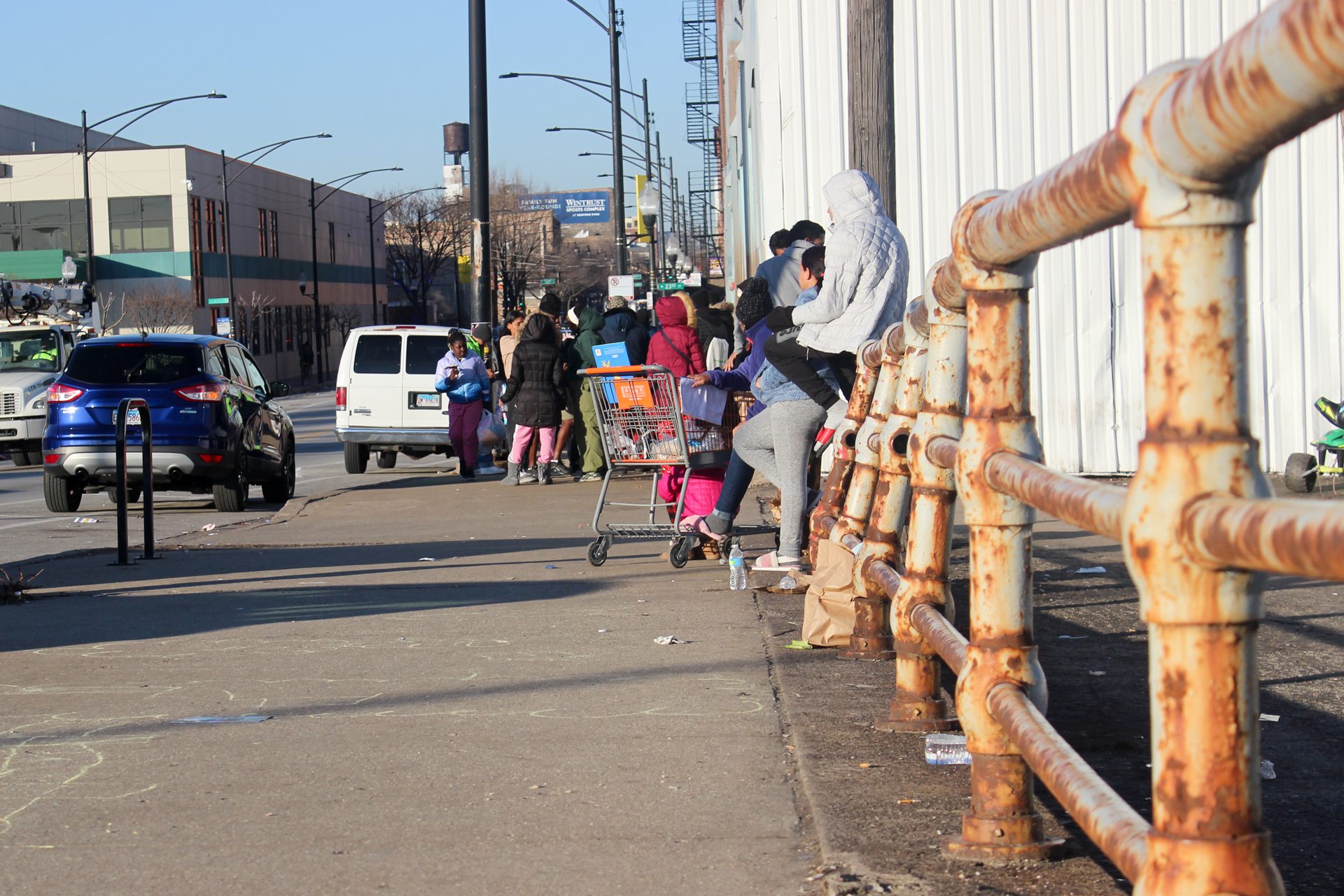
Los migrantes venezolanos describieron las zonas para dormir como abarrotadas, con poco espacio para moverse y sin privacidad para los cientos de personas asignadas a los dormitorios de una sola planta. El albergue permite guardar objetos encima o debajo de los catres, pero prohíbe almacenar alimentos, según los migrantes. Un vídeo mostraba a trabajadores del albergue inspeccionando los catres y tirando los objetos que encontraban.
Muchos de los migrantes que dormían en las zonas A y B del almacén describieron temperaturas gélidas y partículas de "fibra" que caían del techo. Algunos padres con niños en el refugio dijeron a Borderless que sus hijos sufrían infecciones oculares que creían causadas por la caída de escombros.
"Todos mis hijos tuvieron infecciones oculares porque el techo está desprendiendo fibras", dijo María.
Junto con la preocupación por la seguridad del edificio.Los migrantes dijeron que las comidas del refugio a veces se echaban a perder. Afirmaron que en el albergue se sirven los mismos platos todos los días -pollo y arroz- y que la comida suele ser demasiado picante tanto para los niños como para los adultos. Varios migrantes dijeron también que los trabajadores del albergue a menudo racionaban el agua, distribuyendo sólo medio vaso durante las comidas..
En un vídeo revisado por Borderless, se ve a un empleado rechazando a los residentes del refugio hasta las horas designadas para comer mientras llenan parcialmente vasos de poliestireno. "A veces restringen el agua potable", dijo un migrante.
En otro vídeo, los residentes se alinean en la pared del almacén, serpenteando alrededor de algunas de las camas instaladas en medio del suelo, a la espera de comida. "Hay una cola larguísima para conseguir comida", explica una mujer a Borderless. "Tienes que estar de pie dos o tres horas para conseguir comida. Es ridículo".
En las últimas semanas, muchos migrantes han mostrado su preocupación por la propagación de la varicela, las enfermedades respiratorias y la gripe, sobre todo a medida que aumentaba la población. Según los migrantes, una clínica improvisada acude durante unas horas cada ocho días para proporcionar ayuda médica, pero durante esas visitas rápidas se hace poco por los que buscan atención médica. Los migrantes describen largas esperas para ser atendidos sin recibir tratamiento.
"Mucha gente ha enfermado", dice María. Una mujer tuvo que ser operada porque le entró un parásito en el páncreas o el hígado... Su marido dijo que iba a demandarles".
"Todos mis hijos tuvieron infecciones oculares porque el techo desprende fibras".
A una madre frustrada cuyos dos hijos enfermaron recientemente no le dieron ningún medicamento y le dijeron que acudiera a una clínica fuera del albergue si necesitaba ayuda adicional.
Un recién llegado al refugio esperaba recibir antibióticos para recuperarse de una infección de garganta y de la gripe, pero el personal de la clínica no le proporcionó ningún medicamento. Sentado al sol frente al refugio, se sentía frustrado porque no le daban antibióticos ni podía permitírselos después de que le robaran en México de camino a Estados Unidos.
"No hay medicinas", dice su mujer, describiendo su frustración. "Los que no trabajamos estamos en la calle pidiendo ayuda para comprar medicinas. Ahora mismo, mi marido está enfermo. Tiene una infección de garganta [y gripe]. Le han hecho un chequeo, pero no le han dado nada. Ni antibióticos. Ni analgésicos".
Las arduas restricciones de los permisos de trabajo alargan las estancias en los albergues
Muchos migrantes preveían que su estancia en el albergue sería breve, pero han tenido dificultades para conseguir un trabajo que les ayude a encontrar una vivienda más permanente.
En septiembre, el Presidente Joe Biden prorrogó el Testatuto de protección temporal para los migrantes venezolanos llegados antes del 31 de julioun estatus que les permitiría obtener un permiso de trabajo. Sin embargo, el proceso de solicitud es complicado y demasiado caro para muchos. Los que llegaron después de julio no pueden optar al TPS y deben buscar otras opciones, como solicitar asilo, para recibir un permiso de trabajo.
Muchos migrantes recurren a sus redes, con la esperanza de encontrar un trabajo que les permita dejar atrás las condiciones del refugio. Ha sido una lucha, pero ansían intimidad y seguridad para sus familias.
"Quiero trabajar", dijo un hombre a Borderless. "He venido aquí a trabajar".
Algunos han observado que otros migrantes han conseguido trabajos por debajo de la mesa, pero éstos son escasos. Otros han perdido la esperanza y buscan familiares en otras partes de Estados Unidos, con la esperanza de reunirse con ellos en climas más cálidos y escapar de los abarrotados refugios.
Mientras las familias se sentaban a lo largo de Halsted, justo al norte del río Chicago -a unos cientos de metros de la entrada del refugio-, una mujer migrante contó a Borderless que estaba desanimada por la vida en el refugio, la falta de trabajo y una grave enfermedad que la ha desviado.
En los pocos meses que lleva en el refugio, se ha desesperado y anhela la intimidad de su hogar.
"A veces me arrepiento de haber venido", dice entre lágrimas.
Ha pedido ayuda al personal del albergue para acceder a los recursos, pero le han respondido con dureza.
Muchos de los inmigrantes que hablaron con Borderless dijeron que habían optado por callarse y no hablar de las condiciones. Temen que se les eche a la calle o, peor aún, que se les denuncie ante un tribunal de inmigración.
"Te amenazan constantemente", dice María. "Tienes que tener mucho cuidado porque escriben un informe por todo. Si te resbalas, te denuncian y te echan. Es un poco frustrante".
"Nos tratan fatal, como a perros", dice otra joven.
Un jueves por la noche, fuera del refugio, una joven madre que llegó hace unas tres semanas se apoyaba en el cochecito de su hijo y reflexionaba sobre las condiciones del interior. Aunque no son estupendas, no tenía muchas opciones. Su familia ha estado intentando encontrar trabajo limpiando casas o haciendo otros trabajos manuales para poder salir rápidamente del refugio.
Mientras tanto, mientras esperan, "es mejor guardar silencio", dijo.
María* utilizó un seudónimo por miedo a represalias del personal del refugio.
Esta investigación contó con el apoyo del Fondo para el Periodismo de Investigación.

Da poder a las voces de los inmigrantes
Nuestro trabajo es posible gracias a las donaciones de personas como usted. Apoye la información de alta calidad haciendo una donación deducible de impuestos hoy mismo.


